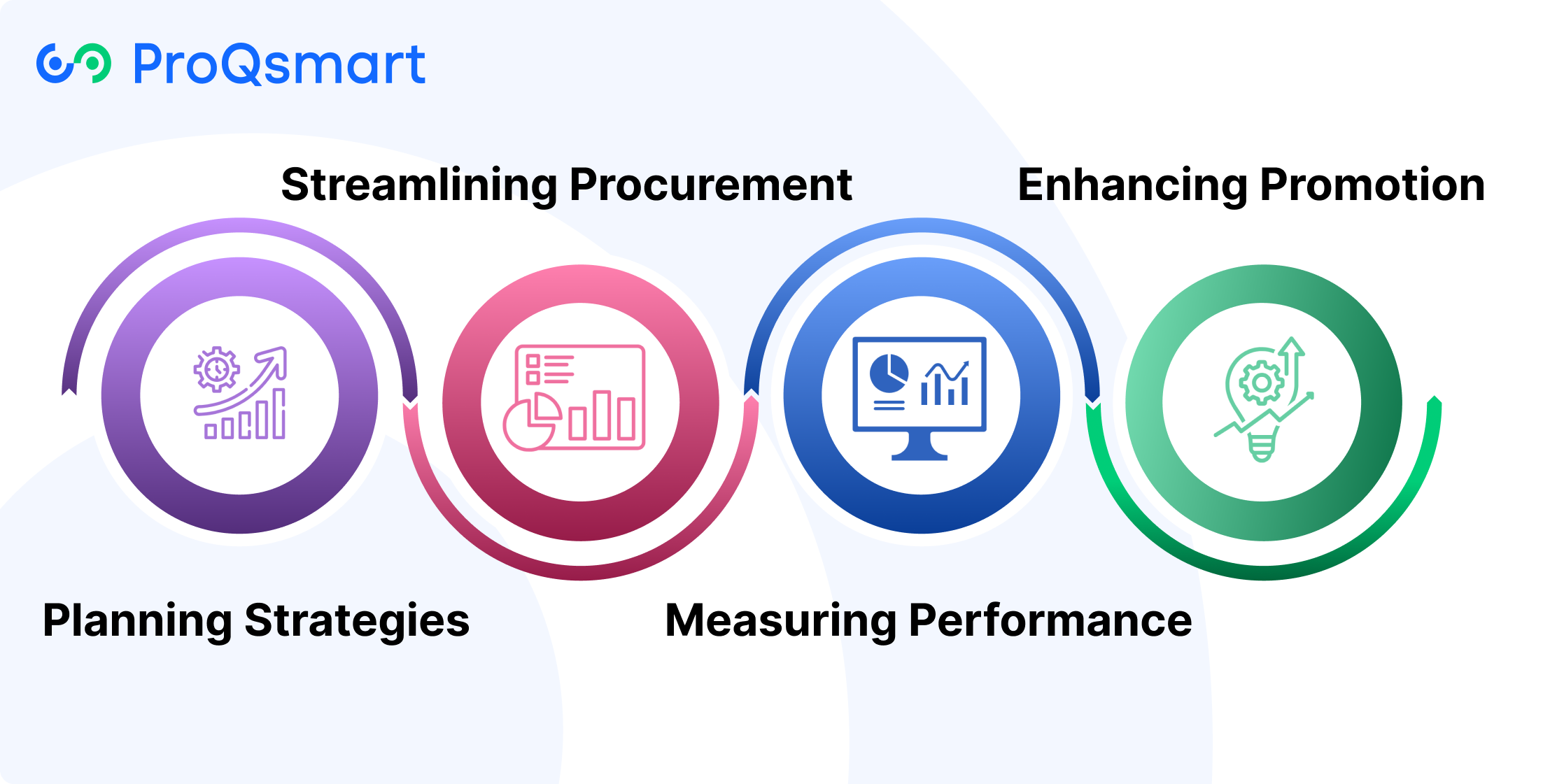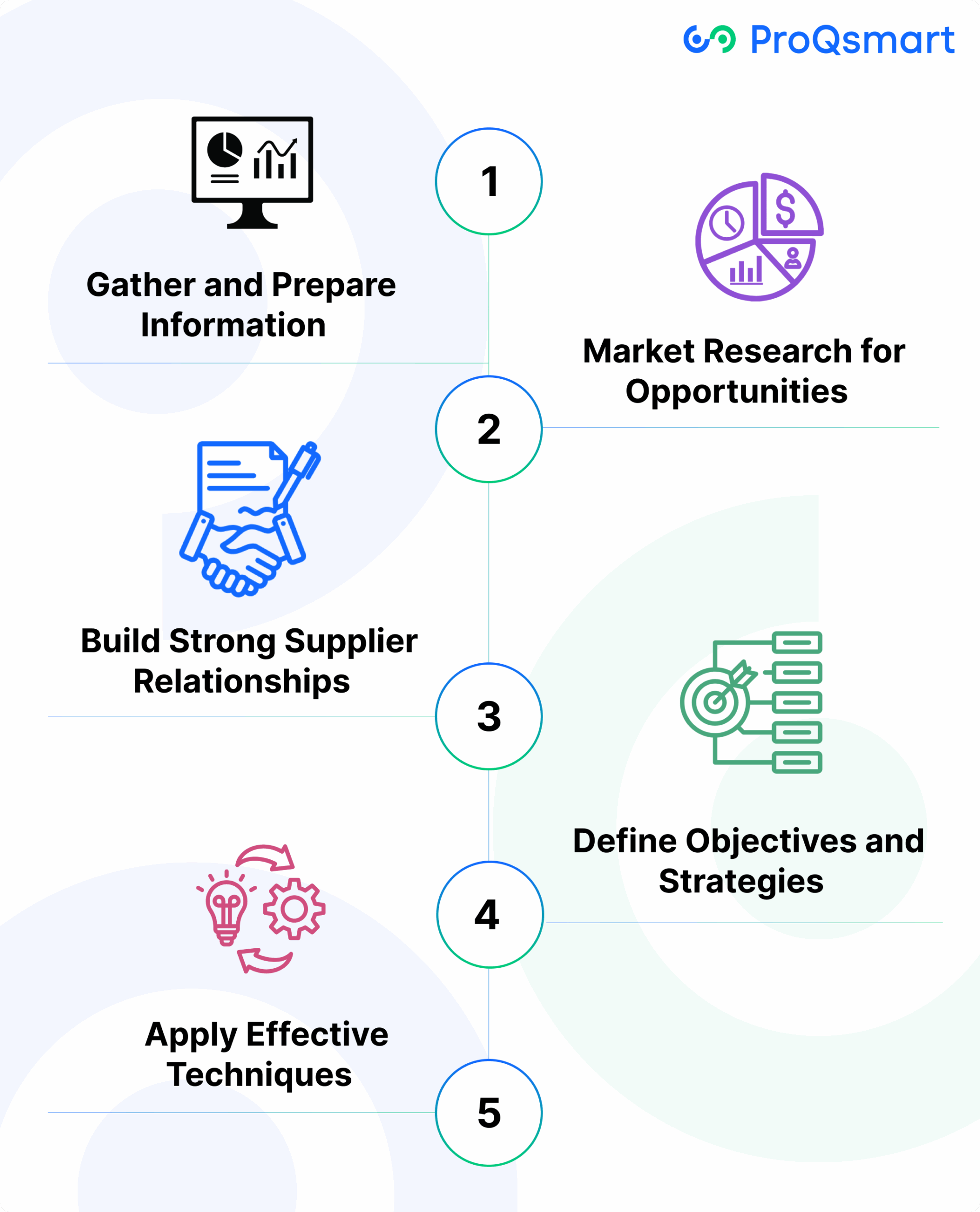Category management is a strategic procurement methodology that involves grouping similar products or services into distinct categories to maximize value and efficiency. By organizing procurement efforts in this way, businesses can analyze spending patterns, negotiate better contracts, and align sourcing strategies with overarching organizational goals. This approach not only simplifies procurement processes but also enables companies to leverage economies of scale and improve supplier collaboration.
Through category management, procurement teams gain deeper insights into market trends and supplier capabilities, empowering them to make informed decisions that drive cost savings and operational improvements. Additionally, it fosters innovation, strengthens supplier relationships, better manages demand to mitigate risks, and ensures consistent quality across categories.
Effective category management is crucial for procurement professionals seeking to enhance efficiency and drive sustainable growth. In the following sections, we will explore practical strategies, tools, and best practices to implement or refine category management processes for optimal results.
Category Management in Procurement
Category Management Key Principles
Creating strategic alignment, making data-driven decisions, and fostering collaboration with stakeholders—these attributes form the bedrock of effective category management. At the heart of this approach is leveraging robust data analysis to establish category profiles and develop informed strategies.
For instance, analyzing spend data within the category focuses efforts on significant cost-saving opportunities and overall market trends inform long-term planning. That’s why collaboration between departments and with suppliers increases success rates dramatically.
Suppliers as “category captains” can provide strategic insights and help develop category management strategies. ProQsmart’s AI-driven platform facilitates this collaboration by offering tools like real-time tracking, supplier performance monitoring, and automated workflows, ensuring alignment with organizational budgets and compliance requirements.

Why Category Management Matters in Procurement
Here’s why category management is one of the most important strategies in procurement today. It provides a framework for organizations to aggregate like areas of spend for category-level management and optimization.
By structuring procurement activities into distinct categories, organizations gain efficiency, innovation, and savings while developing a proactive procurement mindset that looks toward the future.
Category Management’s Impact on Optimization
Without category management, procurement professionals fall short of making measurable, cost-effective and operationally efficient differences. Organizations with mature category management practices report a median supplier lead time of only six days.
Conversely, organizations without these frameworks feel the impact with an added 14-day lead time. This efficiency is a result of using deep category knowledge to target procurement efforts, drive efficient supplier competition and realize better contract conditions.
Cumulatively, these practices significantly improve organizational performance by ensuring procurement activities are closely aligned with overarching business objectives, thereby trailing sustained value creation.
Structuring Spend with Categories
Smart spend categorization sets the stage for stronger category management practices. Some proven methods include segmenting spend by product type, service, or supplier.
Analyzing historical spend data to identify patterns and trends is also crucial. Additionally, grouping maverick and tail-end spend for consolidated management can enhance effectiveness.
These defined categories provide for greater visibility and control, enabling teams to optimize resource allocation and prioritize efforts based on data.
Strategic Sourcing Through Category Management
Category management and strategic sourcing work hand-in-hand. With category management firmly rooted in an organization’s procurement practices, negotiations with suppliers become much stronger and strategic.
ProQsmart further increases alignment by automating repetitive workflows, ensuring compliance, and improving collaboration across departments. It helps you save money thanks to AI-powered insights and real-time tracking.
This integrated approach connects sourcing strategies to clearly defined category objectives, driving compliance to the specifications as well as maximizing value.
Moving Beyond Reactive Purchasing
By reducing risk and promoting the practice of detailed forward thinking, category management takes procurement from a reactive to a proactive space.
Through a holistic approach, it encourages a procurement culture attentive to sustainability, risk management, and coordination with stakeholders. This paves the way toward greater resilience and adaptability.
Four Pillars of Category Management

Category management is a smarter, more strategic approach to procurement. It’s about understanding how to cluster like-kind goods and services to create efficiencies and drive towards larger organizational goals.
At its core, successful category management relies on the four pillars outlined by Stephane Morel at Novartis: aligning to business objectives, accelerating procurement processes, alleviating operational burdens, and advancing automation.
By weaving these pillars into a singular, comprehensive strategy, procurement professionals can guarantee their procurement operations provide real value and evident results.
Planning Strategies
The foundation of good category management starts with strong category planning. Key strategies include conducting in-depth market analysis to identify opportunities, segmenting categories based on spend and supplier significance, and establishing clear, measurable goals for each category.
Aligning category plans with organizational objectives ensures that procurement activities support overall business growth. For instance, if you know your ultimate goal is sustainable sourcing, consider that corporate responsibility is a long-term goal for many companies.
Category management strategic planning, too, fuels market share and sales growth, focusing efforts on the most impactful categories—those where customized approaches can make the most difference.
Streamlining Procurement
Assembling smart approaches to streamline procurement involves finding ways to cut red tape and simplify detailed and complex processes.
Category management makes all this possible by providing a standardized workflow, a path to supplier consolidation, and the use of innovative technology. ProQsmart, an AI-driven procurement platform, streamlines the bidding process with e-tenders, automates bidding workflows and reduces risk while building stronger supplier relations.
Efficient procurement increases responsiveness, cuts expenses, and improves communication with suppliers.
Measuring Performance
Metrics like cost savings, supplier performance, and category ROI are vital for tracking success. Continuous evaluation ensures strategies remain effective, enabling data-driven adjustments.
ProQsmart’s supplier performance monitoringensures contract terms are consistently met, informing future strategies and fostering accountability.
Enhancing Promotion
Promotional activities are enhanced by category knowledge and understanding, resulting in focused timing when consumers are more likely to buy.
For instance, using historical data to pinpoint demand trends can inform targeted marketing campaigns, ensuring the most significant impact on sales.

Steps to Implement Category Management

Successfully implementing category management means having a repeatable process that has been molded to fit your organization’s unique requirements. More than just bringing a disciplined approach to procurement, this deliberate process secures real savings and operational efficiencies you can quantify.
Here are some concrete steps to walk you through this process.
Gather and Prepare Information
The first step in a successful category management process is picking the right data to amass. This can involve analyzing data such as internal procurement records, supplier performance metrics, and external market insights.
Creating competitive benchmarks and visualizing market trends and consumer behavior builds a foundation for data-driven action. As an illustration, understanding how demand shifts with seasons is an important input to inventory decisions. Putting all of this data into easily digestible templates helps provide a clear and uniform method. This process is not quick—it can take weeks—but it sets the stage for your success.
Market Research for Opportunities
Analysis and market research then find out opportunities within each category. Through understanding trends, pricing patterns, and what your competitors may be doing, you can identify opportunities to save money or innovate.
For example, accounting for changes in raw material prices enables better forecasting of future price increases or decreases. Tools like ProQsmart simplify this process by providing actionable market insights and automating data analysis.
Build Strong Supplier Relationships
Collaboration with suppliers is core to the practice of category management. Through transparent communication and consistent trust-building, we create powerful partnerships that lead to greater procurement success.
Real-time collaboration, performance monitoring, and e-tendering features of ProQsmarthelp further this relationship-shaping initiative, making sure that your suppliers are fully aligned with your organizational goals.
Define Objectives and Strategies
Well-defined goals should inform category strategies. These could be achieving savings, reducing risk, or maximizing sustainability efforts.
Aligning these strategies with overarching business objectives helps create a strong interconnected decision-making framework and resource allocation.
Apply Effective Techniques
Utilize technology like ProQsmart’s AI-enabled platform to enhance category management excellence, automate compliance, and streamline procurement processes. Efficient workflows, combined with precise data, empower category managers to standardize procurements, boosting supply chain performance and maximizing ROI.

Best Practices for Category Management Success
To realize success in category management, organizations must take a proven, strategic approach that connects their organizational objectives with market realities.
Prioritize your data-driven insights to help steer your decision-making. Encourage collaboration and preserve agility to shape a robust category strategy that positively transforms your procurement processes.
Below are key practices to enhance your category management initiatives:
-
Understand how data analytics can help you to identify and act on cost saving opportunities, including managing maverick and tail-end spend.
-
Create category plans for quick-hitting wins and future category growth (3–5 years).
-
Keep a profit-and-loss mentality, even knowing your cost drivers such as payable terms and supply chain accountability.
-
Develop better cross-functional teams to help ensure that category objectives are aligned with broader organizational goals.
-
Use technology—including AI-driven category management platforms like ProQsmart—to automate documentation, compliance, and communication to drive efficiencies and safeguard outcomes.
Data-Driven Decision Making
Data serves as the foundation of effective category management excellence. Through analytics, you can pinpoint improvement opportunities, optimize product assortments, and reset category strategies using both internal and market insights. Using platforms like ProQsmart allows seamless integration with ERP systems, offering transparency and automating workflows to drive supply chain performance.
Cross-Functional Collaboration
Collaboration across all departments is crucial for achieving category management excellence, ensuring everyone stays aligned on overarching category goals. Tactics like frequent stakeholder touchpoints and collaboration platforms that provide real-time project insights promote a unified approach to category management initiatives.
ProQsmart’s collaboration capabilities enhance communication and engagement, thereby strengthening supplier relationships and driving better procurement strategies for improved supply chain performance.
Agile Category Adaptation
The ability to quickly adapt to market changes is key. A nimbleness in recalibrating category strategies to adapt to changing consumer trends and macroeconomic forces will be critical to achieving long-term success.
ProQsmart’s budget-driven procurement enables more responsive decision-making by allowing spend to follow where the need is in real-time.
Emerging Trends in Category Management

Category management is still a growing field, as companies grapple with fast-changing market demands, and the introduction of sophisticated technologies and related datasets. By adopting innovative strategies and staying ahead of emerging trends, businesses can transform their procurement processes and drive measurable value.
Here are some of the top trends moving the needle on the future of category management:
-
Heightened adoption of AI and machine learning component to support data-driven decision making
-
Growing emphasis on sustainable and ethical sourcing practices
-
Adoption of omnichannel strategies to enhance consumer engagement
-
Utilization of personalized consumer insights to optimize assortments
AI and Machine Learning Applications
AI and machine learning are revolutionizing category management by providing actionable insights based on vast data sets. These technologies improve demand forecasting, identify maverick spend, and optimize assortments through predictive analytics.
For instance, category managers can leverage AI tools to create data-driven planograms, which significantly reduce shelf-reset failures, currently exceeding 50%. Platforms like ProQsmart integrate AI to automate workflows and manage supplier performance, ensuring decisions are both informed and efficient.
Sustainable and Ethical Sourcing
Sustainability is not an option, it’s an imperative. Utilizing ethical sourcing strategies like consolidating tail-end spend or partnering with environmentally conscious suppliers, procurement can position itself as a driver of corporate responsibility objectives.
More than mere compliance, these initiatives foster customer loyalty and enhance brand reputation, especially as consumers insist on more sustainable practices.
Omnichannel Integration Strategies
Seamlessly integrating online and offline channels is vital. By aligning category management with omnichannel operations, businesses create consistent consumer experiences.
For example, optimizing retail assortments considering inflation and shifting behaviors ensures relevance across platforms.
Personalized Consumer Insights
In short, tailored experiences propel fulfillment. Using tools like ProQsmart, category managers can analyze shopper insights to refine product assortments and enhance customer loyalty through effective category management strategies.

Measuring Category Performance and Profitability
Smart, effective category management excellence fundamentally depends on measuring performance and profitability accurately. By focusing on metrics that truly matter, category managers can make more informed decisions, improve efficiencies, and achieve long-term success.
Key Performance Indicators (KPIs)
Assessing category success begins with defining essential KPIs. Metrics such as sales growth, market share, inventory turnover, and customer retention provide actionable insights into performance.
Aligning these KPIs with overarching business objectives ensures that category strategies contribute directly to organizational goals. For instance, tracking inventory turnover helps identify slow-moving products, enabling timely adjustments to assortment or pricing.
Financial Metrics for Success
Monitoring financial metrics like profit margin, gross margin return on investment (GMROI), and ROI is vital for evaluating category profitability. Analyzing costs and revenues not just identifies where one should improve but guides ways to price and promote your product.
Retailers employing advanced data analytics to measure these metrics have seen profitability improve by 80%. Innovative tools such as ProQsmart make this process easier with built-in financial analysis capabilities, allowing you to make more strategic, budget-oriented decisions.
Supplier Performance Evaluation
Regular evaluation of supplier performance is integral to category management. Criteria such as on-time delivery, quality consistency, and contract compliance determine supplier reliability.
Platforms like ProQsmart automate supplier performance monitoring, fostering transparency and facilitating data-driven procurement decisions.
Conclusion
Category management is a strategic approach to procurement that focuses on grouping similar products or services into distinct categories to maximize value, efficiency, and alignment with organizational goals. By analyzing spending patterns, negotiating more favorable contracts, and leveraging data-driven insights, this methodology empowers organizations to optimize costs, strengthen supplier relationships, and enhance overall procurement performance.
A well-executed category management strategy fosters deeper market understanding, improves supplier collaboration, and mitigates risks by ensuring consistent quality and better demand management. It also supports innovation and operational improvements while aligning procurement activities with broader business objectives.
With the right strategies in place, category management becomes more than just a tool for optimizing spending—it serves as a foundation for building a resilient and efficient supply chain. Whether starting small or scaling up, taking intentional steps today can lead to sustainable growth and long-term value creation.
To unlock the full potential of category management in your organization, explore ProQsmart and book a demo to see how it can transform your procurement processes.




